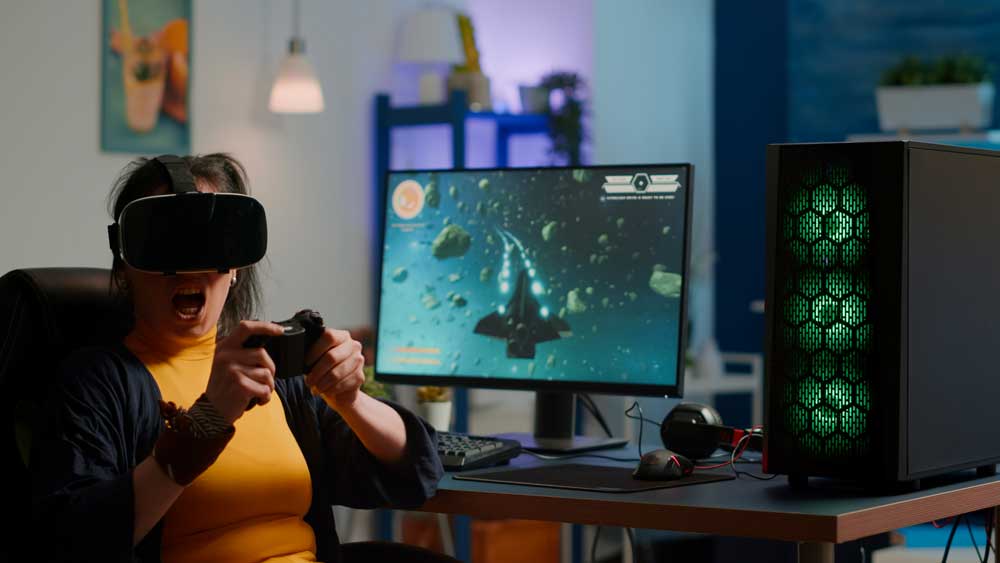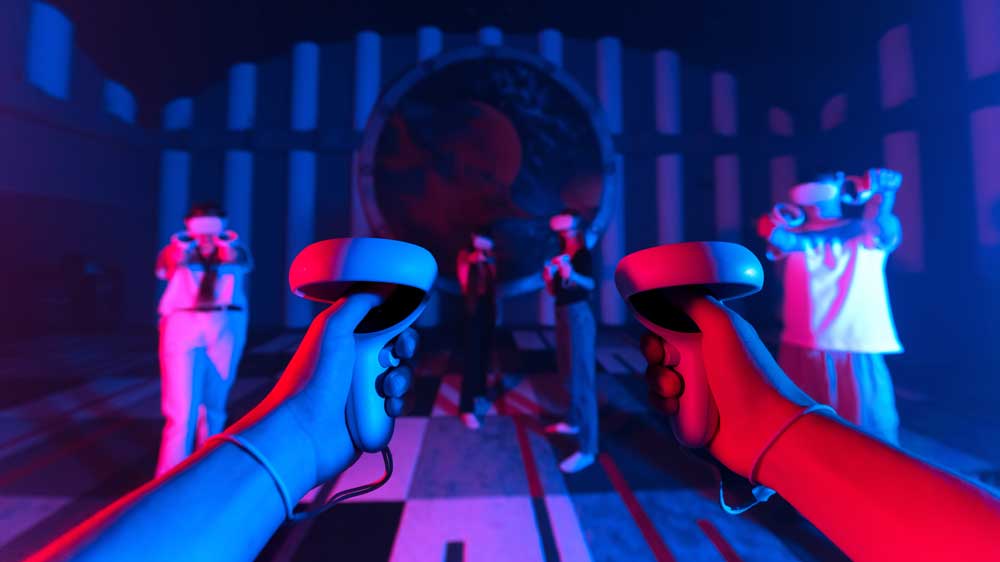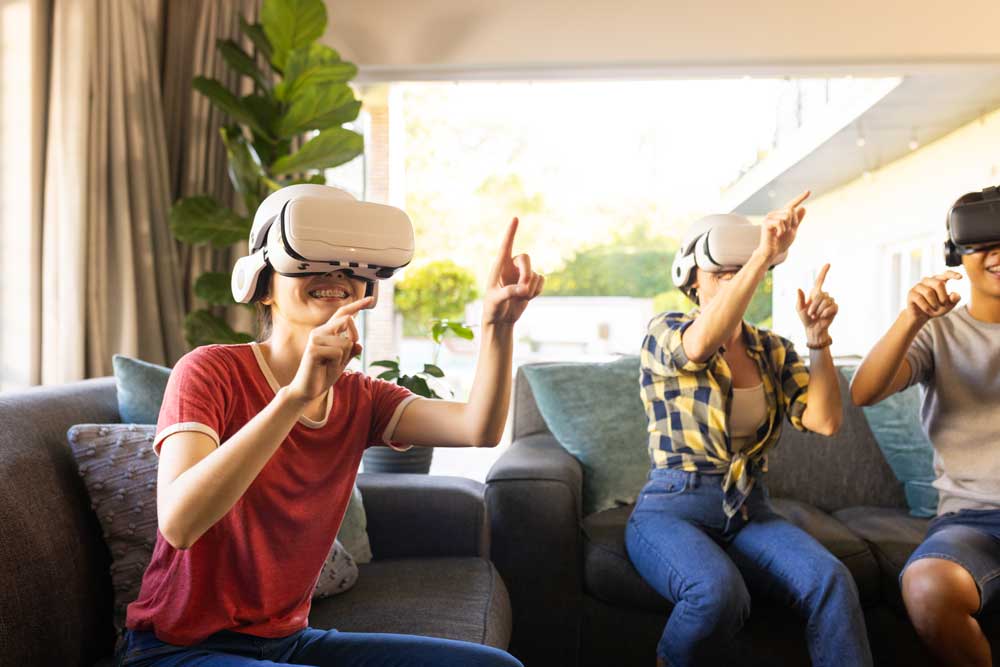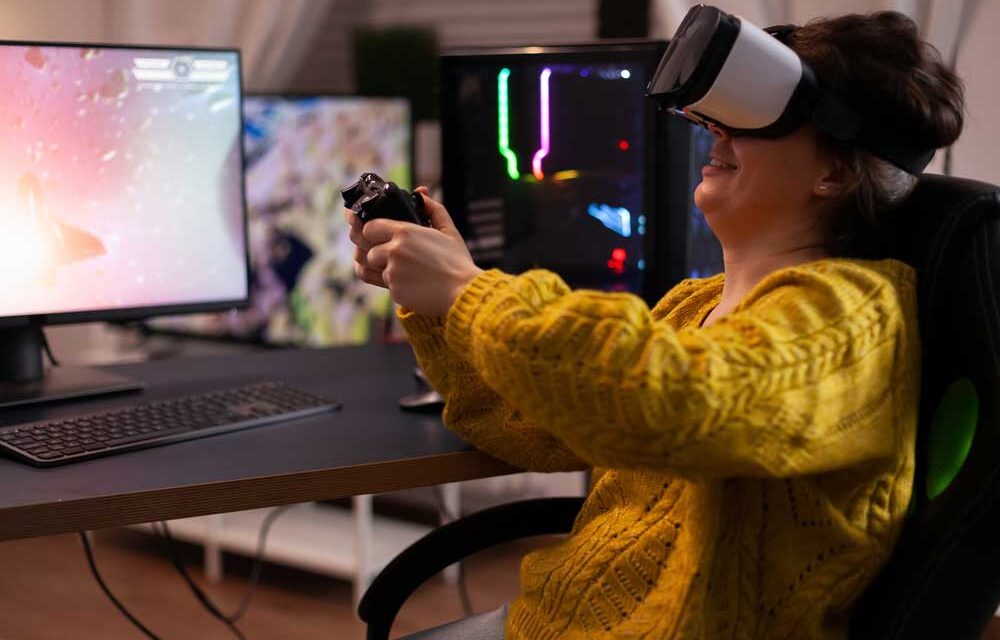How to Develop a VR Game
Without Losing Your Mind or Money
So, you’re about to dive into the pixelated rabbit hole of VR development? Brave. Whether you’re building the next Beat Saber or just trying to get a floating cube to stop spinning off into the void, this guide will help you survive the chaos, with just enough jokes to keep you sane.
Welcome to the intersection of motion sickness, code, and creativity. If you’ve ever dreamed of creating a digital world players can walk through, and maybe crash into walls in real life, this post is your starter map.
Here’s how to develop a VR game without setting your beard on fire, or at least minimizing the scorch marks. Let’s break down the process step by step, with the gritty truths and some Big Digital Bear wisdom.
Step 1: Choose Your VR Platform – Pick Your Poison
What To Pick?
The VR landscape isn’t as unified as mobile or PC gaming. Different platforms have different capabilities, input systems, and requirements. Choosing one upfront helps guide your dev setup and avoid rewriting your game later for a completely different SDK. Each platform has its own SDKs and quirks, like a needy pet. Choose wisely.
Pros & Cons
- Meta Quest (2/3/Pro): Great starting point. Affordable, wireless, massive user base. But it’s underpowered compared to PC VR, so you’ll have to optimize heavily.
- SteamVR (HTC Vive, Valve Index, Pimax): PC-powered = better graphics and freedom. But you’re tied to a beefy PC and a mess of cables.
- PlayStation VR2: Sleek hardware and a big install base—but Sony’s walled garden makes publishing here complex for indies.
Grandma’s Advice On Choosing Your VR Platform
Start with Quest unless you have a good reason not to. It’s easier to test – no cables!, it has solid dev tools, and lets you publish via App Lab before tackling the full store. But yes, your game’s beautiful dynamic lighting? Gone. Welcome to mobile-grade optimization.

Step 2: Pick Your Engine – Unreal vs Unity
Let’s not start a holy war, but here’s the rundown:
- Unity: Great for beginners, massive community, tons of VR plugins. C# scripting.
- Unreal Engine: Gorgeous graphics, Blueprints for visual scripting, C++ for power users.
If you’re a visual learner or want less coding upfront, Unreal is dreamy. If you like fiddling under the hood and quick iterations, Unity’s your jam.
What’s Happening Here?
This decision shapes your workflow, your scripting language, your plugins, and often your sanity. Both Unity and Unreal are fully capable of making great VR games—but they have different vibes.
Pros & Cons
- Unity: Fast iteration, easier to learn, huge community, and plenty of VR packages like XR Interaction Toolkit. Downsides? It can feel like you’re duct-taping features together.
- Unreal Engine: Gorgeous visuals out of the box, amazing lighting and physics, and Blueprints let non-coders get a lot done. But it’s heavier, has a steeper learning curve, and loves to crash right when you don’t save.
VR Battle Unity VS Unreal
If you’re solo or new, Unity is a smoother on-ramp. If you’re already into 3D art, Unreal will make your stuff look AAA even if your gameplay is “throwing rocks at cubes.” Pro tip: don’t get stuck engine-switching mid-project, it’s a black hole of regret.
Step 3: Set Up Your VR Development Environment
Here’s your typical checklist:
- Install the engine (Unity Hub or Unreal Launcher)
- Download the SDK for your VR platform (Oculus SDK, OpenXR, etc.)
- Plug in your headset and make sure it connects (this will break at least once, it’s tradition)
- Create a new VR project using a template to save time
Setting Up a VR Environment is Not Easy
This is the not-so-glamorous bit where you install 20 things, follow 50 tutorials, and spend an hour wondering why your headset won’t connect… only to find the cable was unplugged.
Pros & Cons
- Pro: Once it’s set up, you can test in real-time and see your changes immediately in VR.
- Con: This part sucks. Drivers, SDKs, input mapping—there’s always something broken. You’ll Google “why can’t Unity see my headset” more times than you’d like.
Real Pain – VR Development Environment
You’ll wrestle with settings. OpenXR vs Oculus Integration vs SteamVR Plugin—it’s an alphabet soup. But once you get that first cube rendering in your headset? Pure joy. Save your setup as a template so you don’t have to repeat the pain.

Step 4: Learn the Core of VR Game Design
Here’s where it gets juicy. VR is not just a 3D game slapped on a headset. Think:
- Player Comfort: Avoid motion sickness by limiting camera movement. Teleportation is your best friend.
- Interaction: Players expect to grab things. Physics-based hands are cool, but clunky if not done right.
- UI/UX: Traditional menus don’t work. Use wrist menus, holograms, or diegetic elements (like in-world tablets).
TL;DR – if it makes someone throw up, don’t do it.
What is VR Game Design?
VR design isn’t just flat game design in 3D. It’s a full-body, full-sensory experience. Everything, from movement to menus, has to feel intuitive and immersive, or else users will quit, or hurl.
Pros & Cons
- Pro: When done right, VR is magical. Players feel present. Immersion is unmatched.
- Con: Bad design is punishing. Poor movement makes people nauseous. Clunky interaction breaks immersion. Flat UI? Basically invisible in VR.
Real Problem With VR Game Design
Your game’s biggest killer isn’t lack of content, it’s lack of comfort. Playtest everything. Movement should be slow, interactions should be intuitive, and players should want to explore. Hint: diegetic menus, in-world tablets, wrist UIs, beat popups every time.
Step 5: Build a Prototype Or “Is Harder Than I Thought” Phase
Start small. A room. A cube. Maybe let the cube explode when touched. Congrats, you’re a VR developer now.
Add features iteratively:
- Player movement (teleport or joystick)
- Object interaction (grabbing, throwing, smashing)
- Basic enemies or puzzles
- Sound and haptics (immersion++)
You take your shiny ideas and try to make something playable. It’s ugly, broken, and full of placeholder everything, but it moves. And that’s huge.
Pros & Cons
- Pro: You get a real sense of what works and what doesn’t. It’s your MVP (minimum viable prototype).
- Con: You’ll spend 5 hours debugging why a button doesn’t grab properly… only to find a collider was missing.
Build First VR Game
Your first prototype will be bad. Embrace it. Build a tiny loop: teleport, grab, interact. Keep scope criminally small, no enemies, no inventory, no crafting. Test early. Expect weird bugs like “my hands flew across the map when I pressed A.”
Step 6: Test, Iterate, Repeat
VR bugs are special. Sometimes your hand will disappear. Sometimes the world flips upside down. It’s like QA in Wonderland. Get feedback from real users early. And by users, I mean friends you mildly trust. Watch them play (and flail).
Testing Your VR Game
Testing in VR is more than squashing bugs. You’re watching how people move, look around, interact, and feel inside your world. You’re also trying not to die of headset sweat.
Pros & Cons
- Pro: You’ll see players do things you never expected. Some of it genius, some of it cursed.
- Con: You have to test everything in VR. That means strapping on a headset 1000 times to tweak button placement by 2 inches.
Lets Other Users To Test Your VR Game
User feedback is gold. Watch how testers behave, do they flinch at enemies? Do they miss UI prompts? Are they confused? Fix those pain points. Pro tip: record sessions, with permission. So you can see behavior patterns you might miss in the moment.
Step 7: Polish and Publish
Once it’s stable (or at least doesn’t crash every time), think about publishing:
- Meta Quest: Use App Lab to release without full store approval.
- Steam: Submit via Steamworks and get your game up for the PC VR crowd.
- Itch.io: Perfect for indies and experimental projects.
Remember to optimize your game. Frame drops in VR are nausea fuel.
Publish Your VR Game
The game works. People can play it. You’ve optimized it, hopefully, added polish, and now it’s time to push it out into the world.
Pros & Cons
- Pro: Publishing on App Lab or Steam is surprisingly approachable. You don’t need a AAA studio badge to get noticed.
- Con: Polish takes forever. Lighting, haptics, UI tweaks, voiceovers—it adds up. Plus, if you didn’t optimize early, Quest builds will choke.
Your VR Game Is Live
Release early and often. App Lab lets you update frequently. Don’t wait for perfection, it’ll never come. Once live, market it like a madman: Twitter clips, TikToks of funny bugs, dev logs. VR players love scrappy indie devs who share the journey.
Real Devs Share Their Wildest VR Bugs
No dev finishes a VR game without collecting some truly unholy bugs. Here are a few gems from brave developers who lived to tell the tale:
“The player’s virtual hands kept slapping themselves in the face every time they picked something up. Turns out I accidentally parented the hand to the head collider. Immersion: 0.”
“My NPCs were polite during the day… but at night, they’d silently T-pose and float around like haunted mannequins. I forgot to turn off their nav mesh agent at bedtime.”
“One bug made objects explode when grabbed. Not ‘boom’ explosion—more like ‘instantly teleported to another dimension at Mach 12.’ Great for laughs, bad for gameplay.”
“Player would teleport to random spots if they touched water. Not just in-game water—even the water shader on a painting. I cried.”
Moral of the story? VR development is weird. Embrace the chaos. Post your bugs online—someone else is probably struggling with the exact same physics-defying demon hands. Developing a VR game is like building a spaceship out of duct tape. It’s exhilarating, frustrating, and occasionally explosive. But nothing beats that first moment someone says, “Whoa, this feels real.” Start small. Fail fast. Celebrate tiny wins.
Is VR Game Development the Future?
In a word: maybe, but it’s a very exciting maybe. VR is still a growing niche, but it’s maturing fast. With the rise of affordable standalone headsets like Meta Quest and the growing ecosystem around spatial computing (hello Apple Vision Pro), VR is slowly moving from “cool gimmick” to “real gaming frontier.” Developers now have better tools, open standards like OpenXR, and—most importantly—a hungry community of players looking for new immersive experiences beyond the usual shooters and rhythm games.
But let’s keep it real: VR isn’t going to replace flatscreen gaming tomorrow. It’s still limited by hardware costs, motion sickness, and room-space issues. That said, if you get in now, when the community is tight and the competition is light, you’re planting your flag early. Whether you’re in it for passion, profit, or the sheer chaos of physics bugs, building VR games now puts you ahead of the curve for what’s coming next.
VR Market Growth: The Future’s Wearing a Headset
The virtual reality market isn’t just growing—it’s putting on a jetpack and yelling “YEET!” According to Grand View Research, the VR industry was worth nearly $60 billion in 2022, and it’s projected to balloon to $435 billion by 2030. That’s like strapping your piggy bank to a rocket and hoping it lands on Mars. And guess what? People aren’t just buying headsets to collect dust next to their Pelotons. In 2023, 98 million humans willingly put plastic screens on their faces and entered the Matrix. According to Statista, that number’s only going up—like your caffeine intake during a crunch week.
Even folks who don’t own a headset are feeling the FOMO. A Security.org report says 8% of non-owners are planning to buy a VR headset in the next six months. That’s about 14 million new users gearing up to flail around their living rooms like confused Jedi. Basically, the market is growing faster than a Unity project’s file size. So yeah, if you’re building VR games now, you’re not early… you’re just ahead of the inevitable “Oops, I broke my TV while playing again” revolution.

How Good of a CPU Do You Need for VR Game Development?
If you’re serious about developing VR games (and not just building cardboard simulators), you’ll want a CPU that can multitask like a caffeinated octopus.
Minimum Recommended CPU (for development):
- Intel i7 (10th Gen or newer) or
- AMD Ryzen 5 5600X or better
These are the “you’ll survive” CPUs. They can handle Unity or Unreal, a VR headset running in play mode, and maybe even Discord complaining in the background.
Ideal CPU (for serious dev work):
- Intel i9 (12th/13th Gen) or
- AMD Ryzen 7 5800X / 7700X or Ryzen 9 series
These chips give you smoother editor performance, faster light baking, and can handle compiling shaders while your browser has 57 Stack Overflow tabs open.
Why You Need a Beefy CPU
- VR dev = real-time testing: You’re running both the engine and the VR headset, so you need horsepower.
- Light baking, compiling, building: These processes are CPU-heavy and happen a lot during development.
- Multitasking: Expect to run an IDE, a game engine, VR SDKs, browser tabs, and maybe Blender or Photoshop—all at once.
What Happens with a Weak CPU?
- Editor lags like molasses in January.
- Test builds take ages.
- VR preview stutters = nausea simulator.
- General “why is this thing on fire?” energy.
In short: if your CPU is older than your headset, it’s probably time for an upgrade. You don’t need Threadripper levels of overkill, but don’t skimp either, your future self will thank you during that 15th crash rebuild.
Final Words of Wisdom
VR development is like gardening in zero gravity, nothing behaves like you expect, but when it works… it’s magic. Making a VR game isn’t easy, but it is addictive. You’ll be amazed when you step into the world you created—even if it’s just a janky room with floating cubes. That first moment of presence is pure digital magic.
So go ahead. Put on your headset, open your engine, and start building the impossible. And if your first test build crashes so hard it opens a portal to the void? Don’t worry. We all have been there.
Author: Big Digital Bear

